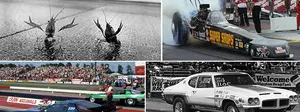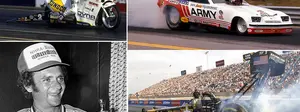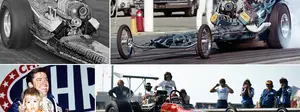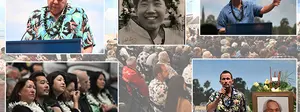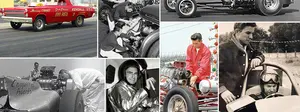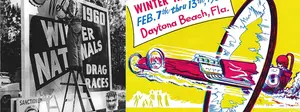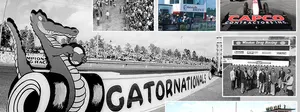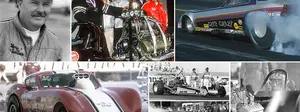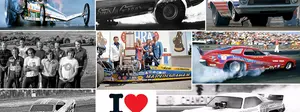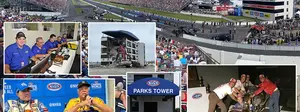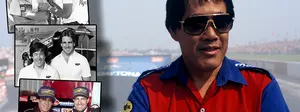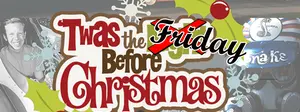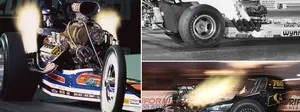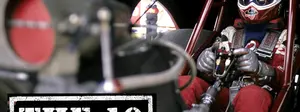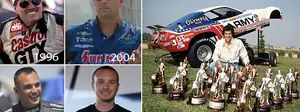'The Man with the X-Ray Eyes,' Part 2
Welcome to Part 2 of our look at the “X-ray” art of Tom West. In Part 1 last Friday, West told about his introduction to the art form with which he has become synonymous and showed off five of his earliest efforts. Today, he’s back with an additional half-dozen and has offered to share even more if you’re interested. I know I am!
Anyway, without further ado, go West, young man! (As last time, clicking on any image below will spawn a larger version for you to ogle.)
 |
"I think this was the first car that I drew where I got the first shot at doing the article with it, for the October 1971 issue of Drag Racing USA, and it was one of my all-time favorites from that point on. I started with a complete photo shoot of the Damn Yankee as it was still being completed by Pat Foster at Woody Gilmore's shop. We could not take it out for some reason, so I shot it from up high just to be able to get back from it a bit ... and it turned out to be one of my favorite angles for a cutaway. As I was still working on that, the car was being prepped for its first time out at OCIR, which was to be on a Friday. I made arrangements with everyone at the GM plant in Van Nuys [Calif.] where I worked to have that day off, but my immediate boss decided that he was going to mess with me and canceled it on Thursday afternoon with a long list of stuff that needed to be done the next day. I got him to agree that I would finish the list and was then heading out, which I did. Still got there in time to see the first burnout and squirt with the car, although the brake calipers shifted, rubbed the inside of the wheels, and broke the brake plates, so not exactly running it down the track the way they wanted.
"We brought it back up and towed it down the track with the chute deployed for the photo series as I messed around shooting from the back of the pickup. Generated some pretty cool photos, as did the stills of the car down there in the pit area at the end of the OCIR track.
"Done, right? Not really, as I came to work Monday morning to find that my schmuck boss had tried to fire me on Friday for insubordination by leaving without checking with him ... as he hid by running in and out of the executive lunchroom for two hours, which would have been grounds for having him fired. He was given a few reasons why filling out my pink-slip paperwork was also going to require him filling out his own; I guess he really went wild. His approach was to now become buddy-buddy with me, telling me that all the stuff I was doing that was supposed to be so good didn't mean anything, as if I wasn't there, they would still get it done. That was really when I decided that I could not work for General Motors.
"So, this drawing is really a symbol for me personally starting to look elsewhere to figure out what I was going to do with my life ... and it was also my favorite illustration for many years."
 |
"I had always done fuel altereds or Funny Cars or other drag cars where the body could be removed for my illustrations, with the last piece of my 'early phase' being the Don Schumacher Stardust car that I did for Marty Shorr at Cars magazine in early 1973. I moved east to go into the model-kit business in March of 1973, living on Long Island for five years, then moving to Michigan to go with MPC as their marketing product manager. While I was there, I reconnected with Steve Reyes, who had become staff photo editor for the Argus group, and he got me over to the Popular Hot Rodding Championships, where we talked about getting me an illustration project.
"That project turned out to be the Pro Stock terror of Richard Maskin and Andy Mannarino, the M&M Boys Firebird. This was for the December 1978 issue of PHR, and I had not done one of these things since early 1973 ... and you could not take the body off of this thing. Realizing that was a bit scary, as I am very literal and try to get everything that I can for my drawings in a set of base photos. Being very literal, I have to know exactly what something looks like to be able to draw it, so it felt like a real stretch for me to even do this piece. Felt like I was walking through a dark room sort of feeling my way along to get all of those 'hidden' details that could not be seen from my camera perspective, but I think it came out fairly well. I also felt like I had actually improved during my hiatus from the X-ray drawings, but I also had figured out that I could make photo prints to use for my base, and I could make them large enough that I had abandoned my earlier grid system of laying out the drawing, so while the process was much harder because of the hidden parts, the stuff that I could see in my photos made things much easier than before.
"Overall, a pretty decent piece by the time it was done ... personal opinion."
 |
"After completing the M&M Firebird Pro Stock while I lived in Michigan, family and work commitments kept me away from the board until I moved back to California in 1984 as director of marketing at Revell. After some corporate things happened, the company was sold to an investor group and was being merged into Monogram in Chicago, but I was helping to get everything going to complete our product line to turn over to them at the end of 1986. As part of that process, I made the trip to Ocala [Fla.] to do the research package on the Swamp Rat XXX, which was about to win its third straight Top Fuel title. This was a full-day shoot, and I worked in my photos that I needed for the illustration that you see here.
"Because I was leaving Revell (I chose not to move back to the Midwest), I was still doing some follow-up work for the line, which included a trip to Gainesville to shoot the new graphics, which were to appear on the model kit. I was working a bit on the drawing, but not pushing, until I met Dr. Bob Post, who was setting up the arrangements to get the car into the Smithsonian Institution. He said it would really be great to be able to include the cutaway in the display material that went with the car, so I hustled to complete it, and the print was displayed in the very front of the first display, and the layout of the permanent display panels was built around a backlit negative of the car that I had provided.
"It was interesting that Bob called after I had sent the piece back there to ask me to reverse the type on the Swamp Rat, as the artist who was laying it out had liked the drawing reversed and arranged the entire layout with it backwards. I told him that I could do what he asked, but that when you look at the car, it will be wrong from front to back, with the front-axle offset going the wrong way, the interior controls being completely backward, the engine being wrong, and all of that. I told him I didn't have the time to make all those corrections, and I did not think that he wanted to display something like this with the short fix that he had requested. He called me back later that afternoon and said that they had completely redesigned that big backing panel to fit with the drawing as it was. It gave me a great deal of respect for Post and for the authenticity that they try to bring to the displays in the Smithsonian.
"This was now the second illustration that I had done since 1973, and it was going in one of the most prestigious museums in the world. I am still very proud to be able to say that one of my pieces was displayed in the Smithsonian for 15 years, or whatever it was."
 |
"Here’s one of my favorite cars of all time ...
"I think that a large number of drag racing fans would claim the 1969 Chi-Town Hustler as one of their favorite cars in the history of the sport. It was known for doing the 'Chi-Town' burnouts that really made the whole Funny Car class come alive to take over the sport. I decided that I should do a cutaway on the car, and [Austin] Coil and the guys agreed to let me do my photos after a race one night at OCIR. We took the car back to the infamous Marco Polo motel and took the body off and all of that stuff while I shot from a second-floor balcony ... in complete dark. We could not put any light on it because it was like 3 in the morning. I set up my camera, which was an old Mamiya C3, which means nothing except that it was like focusing in a cave normally. In the dark, it was just a complete guess.
"I processed the film the next day, only to find that all of my base photos for the illustration were completely out of focus, so I was going to have to rely on the closer detail photos to make this thing correct.
"Selling a piece on this car at the end of 1969 was absolutely impossible, of course, since every drag racing publication had run images of the Chi-Town constantly since it first hit the track, so I just parked the photos, figuring that I would do that piece sometime down the road.
"That time finally came 24 years later when I actually got all of those fuzzy base photos and detail pics out and did this piece. It got published in PHR as part of that retrospective on "The Man with the X-Ray Vision."
"I can only imagine the reaction now if you asked one of the top teams in the sport if you could photograph their car like this after a race ..."
 |
"No introduction needed for the Greer-Black-Prudhomme car, as this is one of the more notable cars in the sport. I wanted to be prepared to do a model-kit or diecast version but also figured that an illustration would be neat, so I convinced Steve Davis to let me shoot it for the cutaway. I just added a bunch of dimensions and other images specific to developing a replica of the car.
"I ended up doing the illustration and made a run of prints of it as part of the fundraiser at the California Hot Rod Reunion, so there seem to be a lot of guys who tell me that they have this piece up in their offices.
"The follow-up to this was the Tommy Ivo twin-Buick dragster, which ended up being part of the Standard 1320 auction to support Eric Fuller's kids after his untimely death. The effort put in by this ragtag group of online drag racing fans and the amazing results might have been one of the finest hours for any Internet group that I am aware of, and I am very proud that I could be involved. I even brought Ivo and [Kent] Fuller back together, as Ivo jumped at the chance to support this thing by sitting at the table with me to sign any of the prints that guys were buying. Fuller came over too, saying that he would sign if the tears did not prevent him from seeing what he was doing.
"Before you think this was a big ego trip for me, I was brought back to reality the next day when some guy came up cradling one of the prints. He said that he had these autographs and knew Ivo's and knew that Fuller built the car, but what was this other one? I said, 'That is my signature; I did the drawing.' He sort of apologized with a disappointed look and walked off. There is always something that makes you realize that you are dealing with a small 'client' base for all of this stuff that we are doing in drag racing.
"The third illustration in this series was a piece on the Magicar of Bill Pitts. I incorporated details from the different versions of the car, the first true Cackle car."
 |
"This is one of the more modern pieces I have done. I had been wanting to illustrate a new-technology Funny Car for quite some time and never came up with an angle. When John Force had his massive crash and came back with the revised safety chassis, I knew that would have to be the one to do. Considering his significance in the history of the sport, I had never illustrated one of his cars, so this one seemed to be a fitting tribute to the fact that John was risking his competitive status to act as the test driver for this new design.
"I talked with him and was invited down to his shop after the Winternationals in 2008, where they pretty much took the car apart for me ... well, close to it. I got all the panels opened that I wanted and even got a look inside the super-secret timer box.
"For me, one of the most satisfying moments with one of these illustrations, or with a diecast car, is when you take it back to the team and get a reaction of, 'Damn, you even got XYZ in this thing.' I had a few of these on this illustration, which is by far the most detailed drag racing piece I have ever done. Having done some of the earlier cars, this was a revelation to me to see how much of the electronic technology was being applied for something that just had to work for about four seconds at a time.
"It’s all part of why I love the most brutal motorsport in the world."
OK, gang, that’s the Best of West so far. Like I said, he has more to share. Next week, we’ll kind of stay on the same track with more “X-ray” photographs sent by the Insider Nation as shown in magazines and other literature throughout the years. Keep the feedback and contributions coming, guys!















